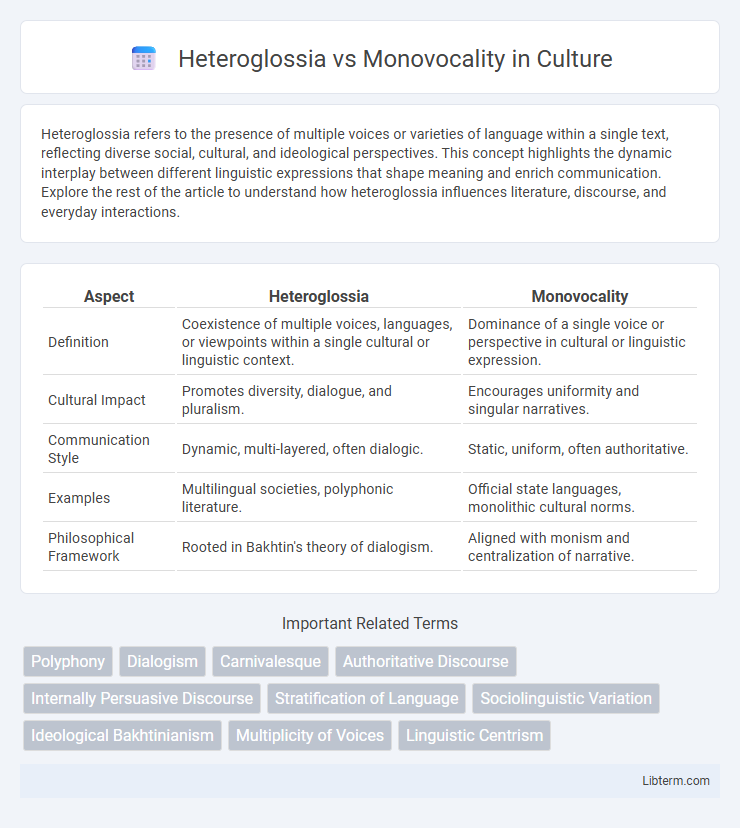Heteroglossia refers to the presence of multiple voices or varieties of language within a single text, reflecting diverse social, cultural, and ideological perspectives. This concept highlights the dynamic interplay between different linguistic expressions that shape meaning and enrich communication. Explore the rest of the article to understand how heteroglossia influences literature, discourse, and everyday interactions.
Table of Comparison
| Aspect | Heteroglossia | Monovocality |
|---|---|---|
| Definition | Coexistence of multiple voices, languages, or viewpoints within a single cultural or linguistic context. | Dominance of a single voice or perspective in cultural or linguistic expression. |
| Cultural Impact | Promotes diversity, dialogue, and pluralism. | Encourages uniformity and singular narratives. |
| Communication Style | Dynamic, multi-layered, often dialogic. | Static, uniform, often authoritative. |
| Examples | Multilingual societies, polyphonic literature. | Official state languages, monolithic cultural norms. |
| Philosophical Framework | Rooted in Bakhtin's theory of dialogism. | Aligned with monism and centralization of narrative. |
Understanding Heteroglossia: Definition and Origins
Heteroglossia, a concept introduced by Mikhail Bakhtin, refers to the coexistence of multiple voices, languages, or perspectives within a single text or discourse, highlighting linguistic diversity and the interaction of social voices. Unlike monovocality, which presents a singular, unified voice or perspective, heteroglossia captures the dynamic, dialogic nature of language shaped by historical and social contexts. This concept originated from Bakhtin's studies of novelistic discourse, emphasizing how language reflects and negotiates power, ideology, and cultural heterogeneity.
What is Monovocality? Core Concepts
Monovocality refers to a unified, singular voice or perspective within a text or discourse, emphasizing coherence and consistency in meaning. It contrasts with heteroglossia, where multiple voices and viewpoints coexist, creating a complex dialogue. Core concepts of monovocality include authority of a single narrative, clear ideological stance, and controlled interpretation to maintain a dominant perspective.
Key Differences Between Heteroglossia and Monovocality
Heteroglossia refers to the coexistence of multiple distinct voices, perspectives, or languages within a single text or context, emphasizing diversity and polyphony. Monovocality, in contrast, features a single, unified voice or perspective, presenting a homogeneous and authoritative narrative. Key differences include heteroglossia's dynamic interaction among competing discourses, while monovocality suppresses alternative voices to maintain ideological coherence and singular interpretation.
Historical Development in Literary Theory
Heteroglossia, a concept developed by Mikhail Bakhtin, emphasizes the coexistence of multiple voices and social languages within a single text, highlighting the dynamic, dialogic nature of language in literature. In contrast, Monovocality reflects a single, authoritative voice that suppresses alternative viewpoints, often associated with traditional, modernist literary theory emphasizing unity and coherence. Historical development in literary theory reveals a shift from Monovocality's dominance towards embracing Heteroglossia, which opened new perspectives on narrative complexity, social interaction, and ideological contestation in literary analysis.
The Role of Context in Shaping Voices
Heteroglossia emphasizes the interaction of multiple voices shaped by diverse social, cultural, and historical contexts, revealing the complexity of meaning within discourse. In contrast, monovocality limits expression to a single, dominant voice that suppresses alternative perspectives, simplifying the narrative and reducing interpretive richness. Context plays a crucial role in heteroglossia by enabling varied voices to coexist and influence one another, while in monovocality, it is often controlled or ignored to maintain uniformity.
Heteroglossia in Modern Media and Literature
Heteroglossia in modern media and literature reflects the coexistence of diverse voices, dialects, and perspectives within a single narrative, enriching the text's complexity and authenticity. This multiplicity of speech genres challenges monovocality, which presents a singular, authoritative perspective, by embracing polyphony to capture the multifaceted nature of contemporary communication. Examples include social media platforms, where users express varied identities, and novels like Salman Rushdie's "Midnight's Children," which interweave multiple cultural narratives and languages.
Effects of Monovocality on Communication
Monovocality in communication restricts the diversity of voices and perspectives, leading to a homogenized and limited exchange of ideas. This reduction in linguistic and cultural nuance diminishes the richness of dialogue, often resulting in misunderstandings and reduced empathy among interlocutors. Consequently, monovocal communication can hinder effective problem-solving and creativity by narrowing the range of viewpoints considered in discourse.
Case Studies: Literary Examples of Both Concepts
Heteroglossia is vividly illustrated in Fyodor Dostoevsky's "The Brothers Karamazov," where multiple voices and social languages intersect to create a complex narrative texture. In contrast, monovocality is exemplified by Ernest Hemingway's "The Old Man and the Sea," which maintains a consistent, singular narrative voice reflecting a unified perspective. These case studies highlight how heteroglossia fosters dialogic richness and ideological plurality, whereas monovocality enforces narrative uniformity and authorial control.
Implications for Language, Power, and Identity
Heteroglossia embodies the coexistence of multiple voices and perspectives within language, fostering dynamic interactions that challenge dominant power structures and enable diverse identity expressions. Monovocality, in contrast, enforces a single authoritative voice, often consolidating power and marginalizing alternative identities and narratives. These linguistic paradigms profoundly influence social power dynamics by either promoting inclusive dialogue and pluralism or reinforcing ideological conformity and identity suppression.
The Future of Dialogue: Embracing Diversity in Discourse
Heteroglossia fosters a dynamic future of dialogue by embracing multiple voices, perspectives, and cultural contexts, enriching discourse with diversity and complexity. In contrast, monovocality limits conversation to a single authoritative voice, stifling innovation and marginalizing alternative viewpoints. Prioritizing heteroglossic interactions in education, media, and policy-making cultivates inclusive communication that adapts to global cultural shifts and advances collaborative problem-solving.
Heteroglossia Infographic

 libterm.com
libterm.com